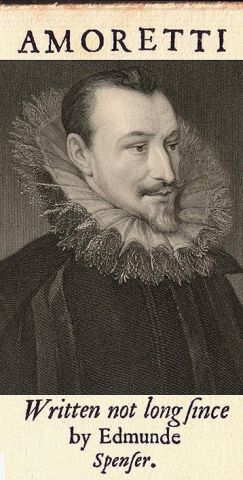 NEW yeare forth looking out of Ianus gate,
NEW yeare forth looking out of Ianus gate,
Doth seeme to promise hope of new delight:
and bidding th’ old Adieu, his passed date
bids all old thoughts to die in dumpish spright.
And calling forth out of sad Winters night,
fresh loue, that long hath slept in cheerlesse bower:
wils him awake, and soone about him dight
his wanton wings and darts of deadly power.
For lusty spring now in his timely howre,
is ready to come forth him to receiue:
and warnes the Earth with diuers colord flowre,
to decke hir selfe, and her faire mantle weaue.
Then you faire flowre, in whom fresh youth doth raine,
prepare your selfe new loue to entertaine.
Spenser ends all his sonnets with a tight couplet. These are always memorable, sometimes quotable, and the perfect way to conclude a complicated set of rhymes. That final couplet is especially necessary in Spenser’s sonnets, because the preceding 12 lines are a bit tangled. A lot of the most famous sonnet writers use an ABAB CDCD EFEF GG rhyme scheme, kind of like three separate 4-line poems followed by a couplet. But Spenser made things more complicated: ABAB is a good start, but then he picks up the B again and does BCBC, followed by more C in CDCD and then the couplet standing alone. Technically you get two little couplets in the intersections (the BB and CC lines), but they’re strung between the quatrains and their energy is dispersed away from each other. The result is a complex interweaving of rhymes, as one quatrain hands off its final rhyme to the next in a big hurry, not always giving the reader time to finish a thought. People at the time thought of it as very Italian, and people of all times think of it as very cool.
The final couplet is especially important in Amoretti #4 because the rest of the poem is somewhat scattered. The basic idea is simple, even a cliche by Spenser’s time: Spring is like love in bloom. But the way Spenser develops it is oblique: The new year looks out from sad old winter and wakes up Cupid, who starts shooting arrows everywhere. That lets Earth know she better put her pretty green flowery dress on. It’s a little more complicated than that, Cupid is never named, and I’m not sure I got all the personified characters right.
But after wandering around for 12 lines enjoying the standard stuff of love poems, Spenser concludes with a bang, switching suddenly to second person direct address and a strong couplet:
Then you faire flowre, in whom fresh youth doth raine,
prepare your selfe new loue to entertaine.
The moral of the story: You’re the earth and I’m Springtime, baby, get ready for love. If the lady was halfway clever enough to keep up with Edmund Spenser, she probably saw that conclusion coming way back when “fresh love” got out of his “cheerlesse bower,” but there’s nothing like a clear statement to make sure woo-er and woo-ee are reading off the same script.
Biographically speaking, Spenser was quite a bit older than the Elizabeth who he was (successfully!) pitching woo at, so he’s playing with some “January-May” romance imagery, and those images take some time to deploy. Poetically speaking, he hasn’t been just dilly-dallying, but setting before his one reader (“seek her to please alone … I care for other none,” as he said in Amoretti #1) a carefully chosen set of images which will make his argument for him, indirectly.
Ilona Bell, in her book Elizabethan Women and the Poetry of Courtship, examines this sonnet’s final lines and unpacks the meaning of the word “Entertain” thus: “to receive as a guest; to keep in mind with favor, to keep oneself in the frame of mind for; the primary meaning is to hold mutually, to hold intertwined.” Spenser is always alive to multiple meanings in his words.
In Amoretti #4, Spenser invites Elizabeth to prepare herself for his offer of love, but his poem has already been preparing her for three quatrains before the couplet.